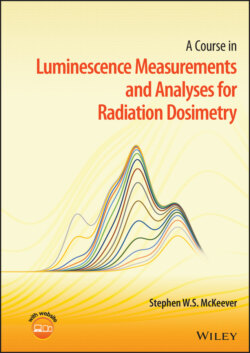Читать книгу A Course in Luminescence Measurements and Analyses for Radiation Dosimetry - Stephen W. S. McKeever - Страница 18
1.2 Introductory Concepts for TL, OSL, and RPL 1.2.1 Equilibrium and Metastable States
ОглавлениеConsider a luminescence dosimetry material in its equilibrium state (Figure 1.1) in which all electrons are in their equilibrium energy levels. Perturbation from the equilibrium state by absorption of energy from an external energy source (radiation) raises the system to a metastable state, in which some electrons now occupy higher, non-equilibrium energy levels. The metastable state is characterized by potential energy barrier(s), which need(s) to be overcome before the system can return to equilibrium. The system may be stable in the metastable state from fractions of a second to thousands of years, depending on the size of the potential energy barrier(s). Absorption by the system of energy from an external stimulus while in the metastable state can overcome the potential barrier(s) and cause the system to relax to its stable equilibrium state. The stored energy may then be released, usually in the form of heat, but a portion of it may be released in the form of visible light and, thus, luminescence may be emitted. The intensity of the luminescence is related to the amount of energy initially absorbed during the irradiation phase. If the stimulus provided is in the form of heat energy, the luminescence emission is TL. If the stimulus involves the absorption of optical energy, the luminescence emission is OSL. (An animated version of Figure 1.1 is given on the web site, under Exercises and Notes, Chapter 1.)
Figure 1.1 Conceptual notion of TL and OSL in which a system in an equilibrium state is perturbed from that state to a metastable state through the absorption of energy from radiation. Once a stimulus is applied, in the form of heat or light, the system is triggered to return to equilibrium, along with the release of a portion of the absorbed energy in the form of light. If the stimulus is heat, the light emission is TL; if the stimulus is light, the emission is OSL. An animated version of this figure is available on the web site, under Exercises and Notes, Chapter 1.
To examine the nature of the equilibrium and metastable states it is necessary to consider the energy band gap of the material and Fermi-Dirac statistics.
